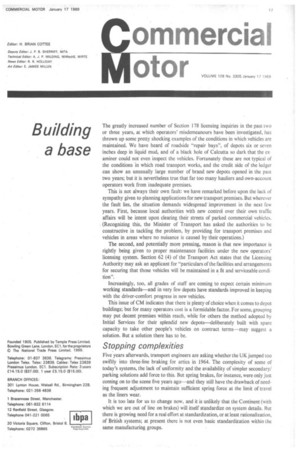Building a base
Page 19

If you've noticed an error in this article please click here to report it so we can fix it.
The greatly increased number of Section 178 licensing inquiries in the past two or three years, at which operators' misdemeanours have been investigated, has thrown up some pretty shocking examples of the conditions in which vehicles are maintained. We have heard of roadside "repair bays", of depots six or seven inches deep in liquid mud, and of a black hole of Calcutta so dark that the ex aminer could not even inspect the vehicles. Fortunately these are not typical of the conditions in which road transport works, and the credit side of the ledger can show an unusually large number of brand new depots opened in the past two years; but it is nevertheless true that far too many hauliers and own-account operators work from inadequate premises.
This is not always their own fault: we have remarked before upon the lack of sympathy given to planning applications for new transport premises. But wherever the fault lies, the situation demands widespread improvement in the next few years. First, because local authorities with new control over their own traffic affairs will be intent upon clearing their streets of parked commercial vehicles. (Recognizing this, the Minister of Transport has asked the authorities to bc constructive in tackling the problem, by providing for transport premises and vehicles in areas where no nuisance is caused by their operations.) The second, and potentially more pressing, reason is that new importance is rightly being given to proper maintenance facilities under the new operators' licensing system. Section 62 (4) of the Transport Act states that the Licensing Authority may ask an applicant for "particulars of the facilities and arrangements for securing that those vehicles will be maintained in a fit and serviceable condition".
Increasingly, too, all grades of staff are coming to expect certain minimum working standards—and in very few depots have standards improved in keeping with the driver-comfort progress in new vehicles.
This issue of CM indicates that there is plenty of choice when it comes to depot buildings; but for many operators cost is a formidable factor. For some, grouping may put decent premises within reach, while for others the method adopted by Initial Services for their splendid new depots—deliberately built with spare capacity to take other people's vehicles on contract terms—may suggest a solution. But a solution there has to be.
Stopping complexities
Five years afterwards, transport engineers are asking whether the UK jumped too swiftly into three-line braking for artics in 1964. The complexity of some of today's systems, the lack of uniformity and the availability of simpler secondary/ parking solutions add force to this. But spring brakes, for instance, were only just coming on to the scene five years ago—and they still have the drawback of needing frequent adjustment to maintain sufficient spring force at the limit of travel as the liners wear.
It is too late for us to change now, and it is unlikely that the Continent (with which we are out of line on brakes) will itself standardize on system details. But there is growing need for a real effort at standardization, or at least rationalization. of British systems; at present there is not even basic standardization within the same manufacturing groups.








































































































